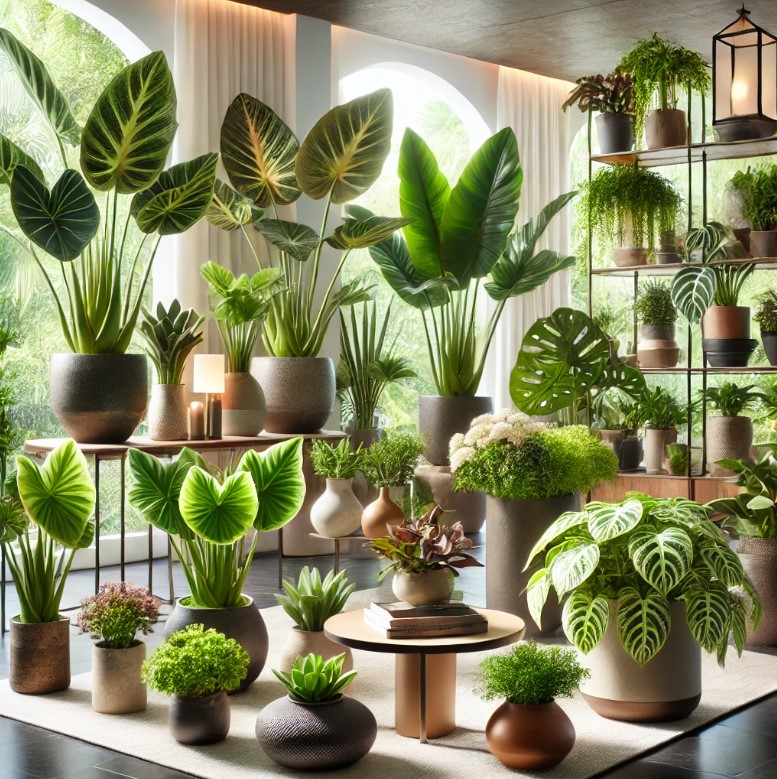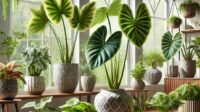
Alocasia plants are a group that have fabulous houseplants in them and their desirable features bring plant collectors or enthusiasts closer to get these beautiful gems. Some of the most common types include Alocasia Dragon Scale and Alocasia Stingray, both very different in looks and care. Even new plant parents check out Alocasia plants, and they all have to wonder what the difference is in-between them so one can choose the finest one for their indoors. In the following sections, we will look at the different types of Alocasia: What They Are and How You Care for Them. Discover these unique species and be prepared with the skills needed to grow these beautiful plants in your home.
1. Popular Alocasia Types – A List on the Different Varieties of Elephant Ears
Alocasia is a genus in the Araceae plant family. Native to tropical Asia and the Pacific Islands, these plants are well liked for their large and often colorful foliage. They are known for their shiny big leaves and the exotic look makes them perfect as indoor decorative plants. There are different types of Alocasia, just like there are different kinds of them.
2. The Alocasia Dragon Scale: A Popular & Majestic Species
Alocasia Dragon Scale – This is the most famous and recognizable Alocasia variety. It has very dramatic, bold foliage with dark green leaves that have silver veins which make them look like dragon scales. Ideal for collectors seeking a flamboyant centerpiece for the home. Alocasia Dragon Scale care requires good humidity, light and water.
3. Alocasia stingray: A standout tasteful selection
Those unique leaves — like the wings of a stingray — are what makes Alocasia Stingray so special. The elongated foliage is dark green with lighter colored veins making it look stunning. Lemon trees are relatively easy to care for although do need some humidity so this would be a good choice for both novice and experienced gardeners.
4. If you’re looking to make a statement but have limited floor space, Alocasia Polly is your go-to.
Alocasia Polly (also called African Mask) is a compact version of this plant that has the same bold, dramatic plant leaves as larger Alocasia species. The leaves of this plant are shiny, dark green with white veins. Alocasia Polly is another fan favorite for those who love Alocasia but want a more compact plant to fit their less-than-mansion sized home.
5. Alocasia Black Velvet – a beauty of darkness and mysticism
Alocasia Black Velvet is another beautiful variety featuring very dark green or even purplish foliage, making a perfect statement plant in any indoor garden. It is sure to have you mesmerized by the succulent smoothness of its leaves. It grows well in low to medium light making it an excellent plant for homes with no direct sunlight.
6. Alocasia Macrorrhiza: A Huge and Beautiful Variety
Giant Taro, aka Alocasia Macrorrhiza is a large Alocasia with tropical style leaves that can grow to 3 feet long. This plant needs a lot of space to grow and it does well in the tropics or in humid areas. Its leaves are huge — this is a floor plant so really more of a statement in airy rooms.
7. Alocasia Azlanii: Another Rare and Gorgeous Gem
One of the more uncommon varieties of Alocasia is Alocasia Azlanii. Its vibrant green leaves are highlighted with pinkish-red veins. This is definitely a notable statement plant to put in any collectors collection. Alocasia Azlanii is not really a high-maintenance plant but needs to be looked after in terms of humidity and watered consistently.
8. Alocasia Lauterbachiana: A Different Precious Plant Like Lady
Alocasia Lauterbachiana “Purple Sword” is one of the showier varieties with elongated leaves that can appear in dark purple or green. Its unique color and shape position this plant beautifully amongst a collection of flowers that may offer a more standard appearance to the average gardener.
9. A More Compact Version of Your Traditional Alocasia: Alocasia Bambino
Alocasia bambino is a smaller and more compact variety of Alocasia. This means that while it is a compact version, it still has large and dramatic foliage just like Alocasia do! This palm is petite so it works wonderfully indoors in smaller homes and apartment settings, still bringing a bit of tropical appeal without taking up much space.
10. Alocasia gageana: A Tough and Indestructible Cultivar
Use Alocasia Gageana, which is a very hardy and easy-to-care-for variety. With big heart shaped leaves with dark contrast veins, it loves the indoors and outdoors in a tropical setting. Alocasia Gageana is a good choice for beginner plant parents or if you want an Alocasia variety that requires little to no fuss.
11. Why Different Types & Varieties of Alocasia Need Varying Levels of Care
There are so many varieties of Alocasia that if you followed everything there is to know about watering lightening, each one need almost following this step. Some types do well with very high humidity while others will grow just fine in dryer conditions. Knowing these needs is important to keep your Alocasia plants happy and healthy over time.
12. Best Lighting Conditions For Alocasia Types
Alocasia plants like bright, indirect light most of the time. Many varieties can manage transformation fantastic in low light (like Alocasia Polly), yet others possible, like Alocasia Dragon Range, need added lighting to keep colour. Lighting conditions should be adapted to the requirements of each variety.
13. Humidity Requirements for Various Types of Alocasia
The ideal humidity to take care of Alocasia plants The majority of types, particularly the big leafed kinds such as Alocasia Macrorrhiza prefer high dampness for survival. To create the perfect environment, use a humidifier or put the plant near a tray of water.
14. How to water Alocasia for healthy growth
Watering is probably one of the most important parts of the Alocasia care. Too much water will trigger root rot to develop, and too little water leaves the plant dry out. Top soil should dry well in between watering so plant has proper amount of moisture.
15. Environmental Pests and Diseases of Alocasia
As with any houseplant, Alocasia strains could be prone to tricks like spider termites, aphids as well as mealybugs. Keep them away by consistently checking your plants and using organic pest control methods. Moreover, keeping your plants clean and well-maintained will also help reduce their exposure to diseases.
Final Thoughts: Which Alocasia is the Right One?
While there are many Alocasia types available, all these choices can make it hard to choose what would suit your indoor area best. Each variety offering something unique whether you are in love with the amazing leaf size of Alocasia Dragon Scale, discovering the unknown which comes with even being able to get your hands on an Alocasia Stingray or even delve into some rare patience and conviction as it may take a while to land yourself the majestic beauty that is up there hanging in heaven bad but for now standing right here down on earth-waiting to be shipped home, called an Alocasia Azlanii. Knowing the care needs and the traits of each variety will help you maintain your Alocasia plants at home.






